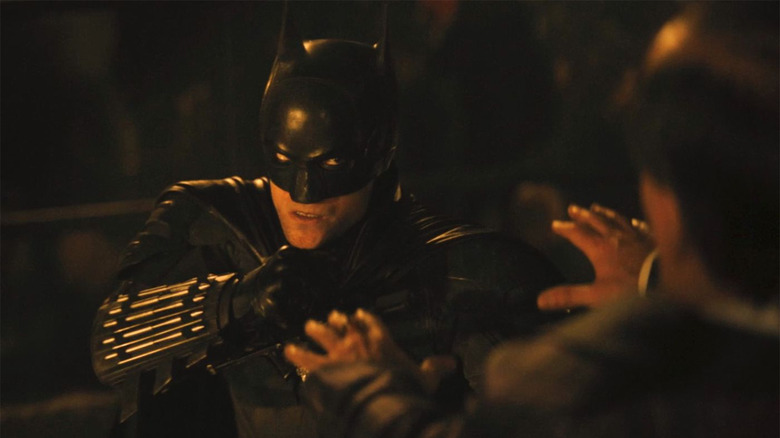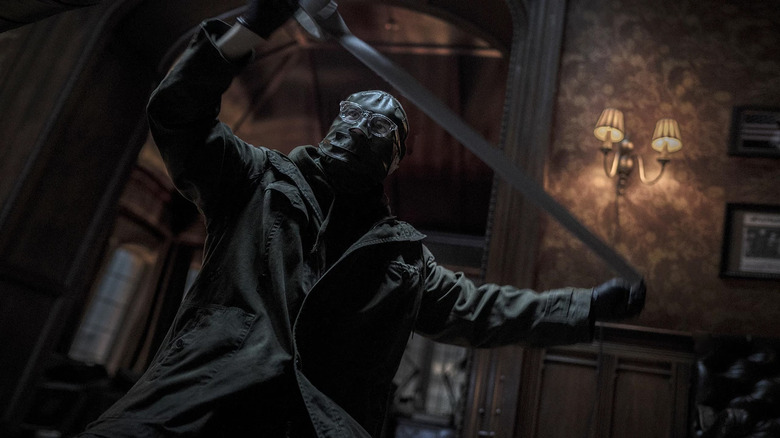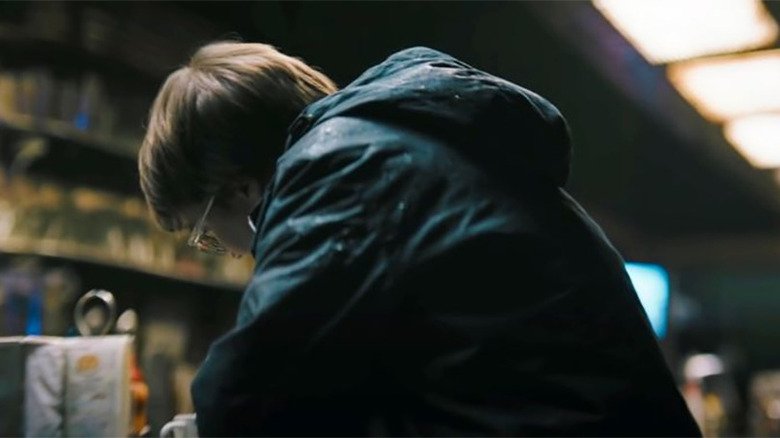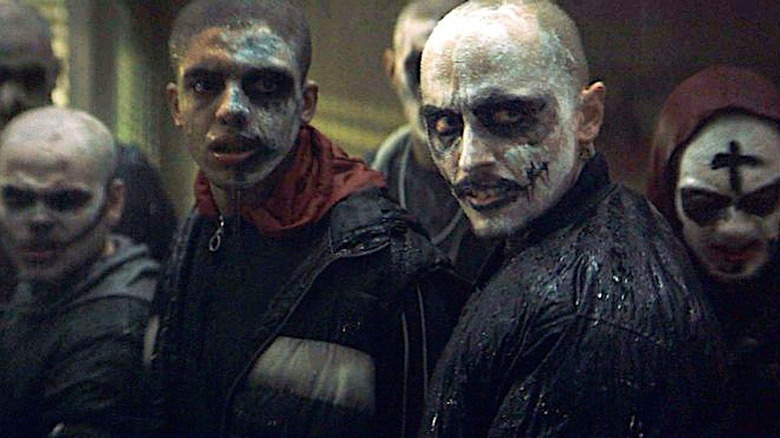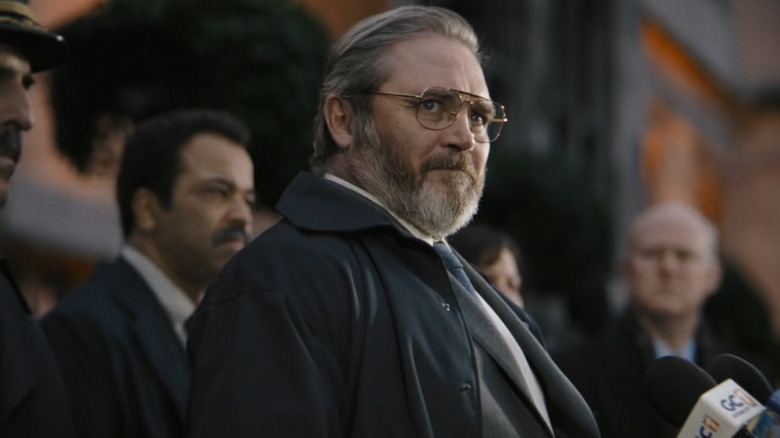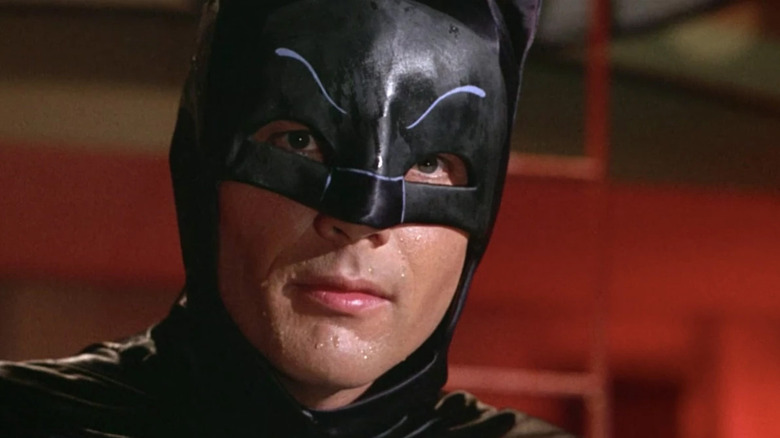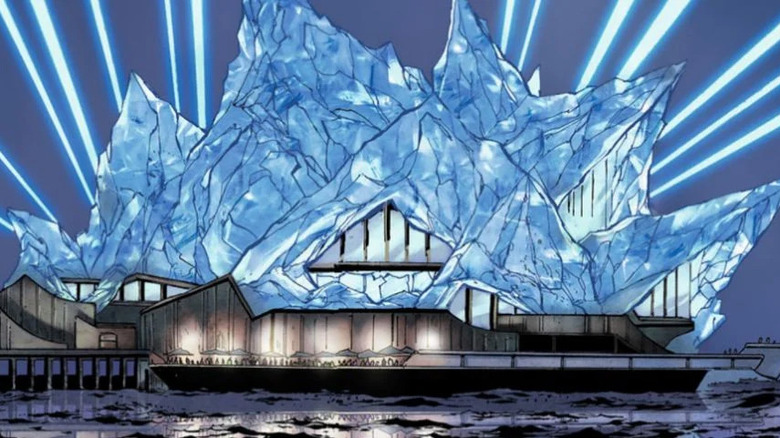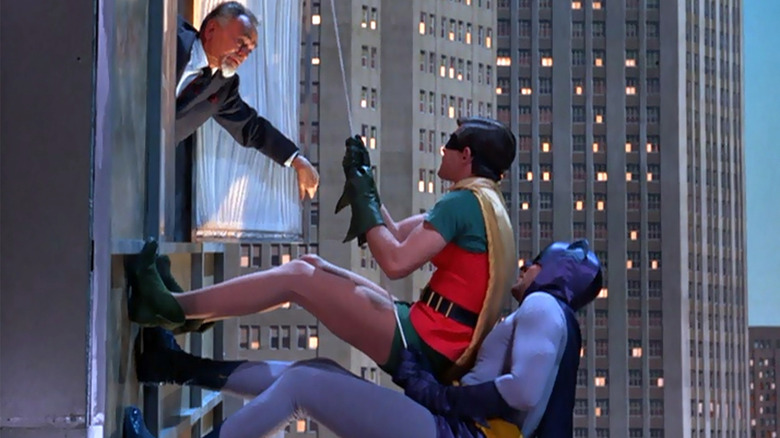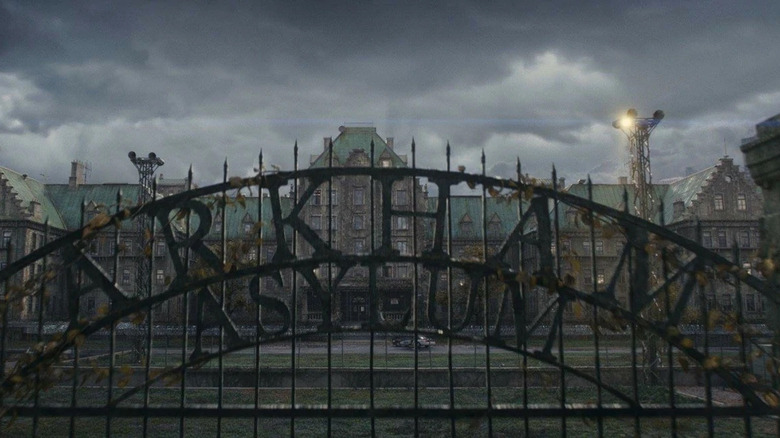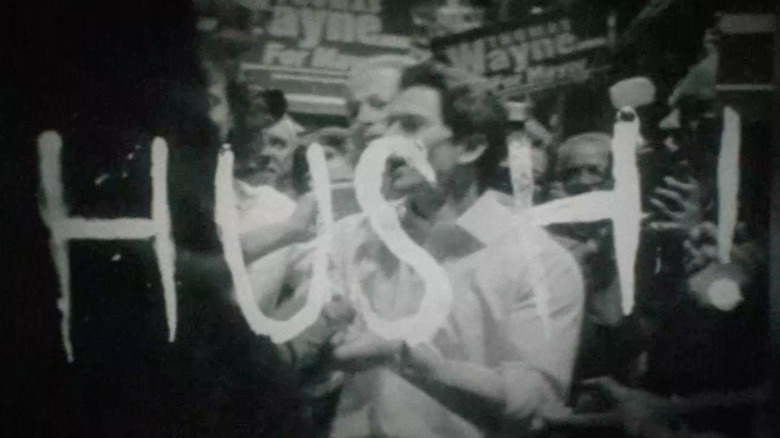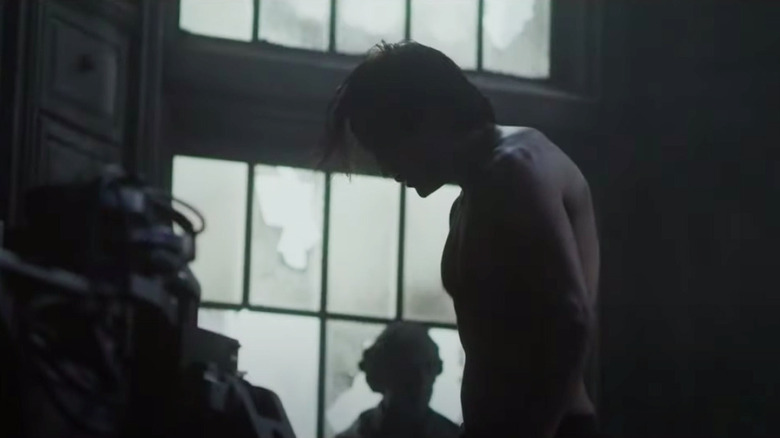The 11 Coolest Easter Eggs In The Batman
The Bat-signal is shining bright as the first public screenings of "The Batman" have officially taken place across the country. With a nearly three-hour runtime (that breezes by), there's more than enough Batman to satiate your hunger for vengeance. Since the movie is rather lengthy, complete with a compelling mystery courtesy of The Riddler, there are plenty of details to pore over alongside DC's Dark Knight detective. If you got caught up in the plot, you might have missed some of the Easter eggs hidden throughout the movie. Director Matt Reeves didn't exactly pack the movie with sneaky references like a Marvel Studios production, but you might be surprised by the number of nods to the campy "Batman" TV series that began back in 1966.
So let's dig into "The Batman" Easter eggs! But beware that there will be some spoilers throughout this list, so don't read if you haven't seen the movie yet!
The Long Halloween and Zero Year
Right off the bat (pun intended), "The Batman" begins on Halloween night. That seems to be rather intentional, because the movie takes some inspiration from the 13-issue comic book series "Batman: The Long Halloween."
In the comic, Batman is trying to track down a mysterious killer named Holiday who is killing someone on a holiday each month. At the same time, there's a crime war between the Maroni and Falcone crime families. "The Batman" very loosely adapts these details, with The Riddler going after the likes of Mayor Don Mitchell Jr., Commissioner Pete Savage, and District Attorney Gil Colson in his riddle-laden killing spree that aims to expose a dark secret within Gotham City. There's no holiday link, but while these murders are taking place, there's also a storyline about the corruption of the Gotham City Police Department tied to a drug bust that was being executed by the Maroni crime family, which was actually orchestrated by Carmine Falcone.
"Batman: Zero Year," a year-long comic book crossover event, may also serve as inspiration for part of "The Batman." There are little details from this comic storyline included, such as Gotham City being destroyed in a flood at the beginning of the story and Batman trying to save the city from the control of The Riddler. Granted, this would be an even more loose adaptation of the comic material, but the flood certainly seems to set the stage for a potential sequel.
The Riddler's different identities
Throughout "The Batman," the identity of The Riddler is a secret — the character is only referred to by his villainous moniker. But when he's finally apprehended by police at the end of the second act, we finally learn who he is. Or do we?
When Riddler is caught by police in a corner diner (a scene glimpsed in the trailer), law enforcement finds several identification cards on his person. One of them says Edward Nashton, referencing the "New Earth" version of The Riddler who would eventually go on to change his name to Edward Nigma later in life. Another ID card says Patrick Parker, which is an alias that the villain has also used in the comics.
Is that Tim Drake?
Halloween is the perfect night for crime to run rampant in Gotham City. On this evening, a gang of thugs with white and black facepaint have been harassing and assaulting innocent citizens. When they chase down a man heading home after a ride on the subway, Batman shows up to deliver justice.
Among the face-painted gang is what appears to be a younger, newer member of the gang being initiated into their ranks, which might explain why only half of his face is painted. As he's encouraged to partake in their criminal assault, he appears reluctant. That hesitant gang member is none other than Jay Lycurgo, who DC fans might recognize as Tim Drake in the "Titans" TV series.
Actor Jay Lycurgo appears as the apprehensive clown gang member, and he's also in "Titans" as Tim Drake, the third iteration of Robin in DC Comics. Lycurgo had actually completed his small role on "The Batman" before he ever auditioned for "Titans," and he even kept his part secret from the rest of his TV co-stars until he was spotted in the trailer.
A Batman '66 deep cut?
Commissioner Pete Savage is a short-lived supporting character in "The Batman" who gets killed by The Riddler. That name may not sound familiar to comic book fans, but it might ring a bell for those who loved the "Batman" TV series that began n 1966. In an episode entitled "An Egg Grows in Gotham," there's a character named Pete Savage, who is a descendant of one of the three families who founded Gotham City. There aren't really any similarities between that character and the one we meet in "The Batman," but since Matt Reeves has proven to have a soft spot for the 1966 version of the Caped Crusader, we're betting it's not a coincidence.
Taking a cue from Adam West
This Easter egg is something you might have noticed as soon as the first images of Robert Pattinson suited up as the Dark Knight became available, but we think it's worth mentioning here. Though "The Batman" is a far cry from the campy "Batman" TV series, there does appear to at least be some influence from the classic show on the design of Batman's new cowl.
Traditionally, if you look back at the various cowls worn by Michael Keaton, Val Kilmer, George Clooney, Christian Bale, and Ben Affleck, they've all had a rather pointy nose, likely inspired by the pointy snout of a bat. Even "Batman: The Animated Series" had a triangular beak. But if you look at the face of Robert Pattinson's Batman cowl, the nose actually looks a more rounded nose piece that resembles the mask that Adam West wore when he played Batman. You can even see the stitching on the headpiece if you look close enough.
The Iceberg Lounge is open for business
For the first time ever, the Iceberg Lounge has made it into a Batman movie. The posh nightclub serves as the base of operations for The Penguin (played masterfully by Colin Farrell in heavy make-up), and even though it's been featured in DC Comics many times since its debut back in 1995, we've never seen it on the big screen until now. There's also the 44 Below Club, which is within the Iceberg Lounge, but as far as we can tell, that doesn't appear to be a DC Comics reference.
Walking on walls
Can you believe there's potentially another reference to the classic "Batman" TV series? We've seen Batman use his grapple gun on many occasions to make a quick getaway, but we've never seen him use it to assist him in running straight down the side of a building. It's an action move we've seen executed in several blockbusters, but in the case of Batman, we can't help but think this might be an allusion to the cheesy camera trickery that made it look like Batman and Robin were scaling a building.
More than an asylum
Arkham Asylum has been seen in many Batman projects over the years, but the namesake has never been featured so prominently on screen. Arkham Asylum is named for the Arkham family, who have a key part in the history of Gotham City. In "The Batman," the Arkham family is featured in The Riddler's revelations of the corruption in Gotham, and yes, Arkham Asylum also plays a part, along with Blackgate Prison.
Carmine Falcone's daughter is...
The revelation that Catwoman herself, Selina Kyle, is actually Carmine Falcone's daughter has origins in DC Comics. In the comic book miniseries "Catwoman: When in Rome," Selina Kyle comes to believe that her father might be crime boss Carmine Falcone. However, she's never actually ever able to find conclusive proof. In "The Batman," it's explicitly stated that Falcone is the illegitimate father of Selina. She tries to kill him as retribution for not only the disregard of her mother but the death of her friend Annika, who was killed by Falcone after she learned that he was the rat who betrayed the Maroni crime family.
Hush!
When Riddler reveals the morally questionable actions of Thomas Wayne while he was campaigning to be mayor of Gotham City, there's an interesting use of the word "Hush!" that might just refer to more than the cover-up of Wayne's supposed misdeeds and the corruption behind his "Renewal" project in Gotham.
The revelation that the Riddler brings to light involves hush money being paid to shut up an investigative reporter named Edward Elliot, who was about to reveal Martha Wayne had a worrisome history of being admitted to Arkham Asylum. When Thomas Wayne reluctantly pays Carmine Falcone to take care of this issue, Elliot ends up being killed by the mobster, thus corrupting Wayne's seemingly clean reputation.
When this information is revealed, the above image can briefly be seen with the word "Hush!" scribbled on footage of Thomas Wayne (you can see it by playing the Riddler's game on the interactive website discovered in the movie). Why is this interesting? In DC Comics, one of Batman's enemies is known as Hush, and he's revealed to be Dr. Thomas "Tommy" Elliot, a childhood friend of Bruce Wayne who has chosen to sabotage his life with a plan hatched along with the Riddler. Could this be a stealthy way of leading to the eventual reveal of Hush as a villain behind the scenes? Or is it merely a fun little Easter egg that Matt Reeves includes for the fans?
To the Batcave
In "The Batman," Bruce Wayne doesn't appear to have a gimmicky way of getting into the Batcave from his residence. However, there is a tribute to one of the famous methods of entering the Batcave that again reaches all the way back to the classic "Batman" TV series.
In the "Batman" TV series, Bruce Wayne concealed a button that opened the secret entrance to the Batcave by way of a pair of sliding poles within a bronze bust of William Shakespeare. That bust can be seen in the background of a shot (above) featuring a shirtless Robert Pattinson as a brooding Bruce Wayne, as seen in DC FanDome's featurette from October 2021. Even if the bust can't be easily seen in the final cut of the movie, it's good to know it's sitting around there somewhere.
Who knows what other treasures lie within Wayne Tower? We'll have to get a closer look whenever the movie arrives on home video. In the meantime, enjoy "The Batman" in theaters as much as you want, especially since the rest of the big screen competition is pretty much non-existent.
